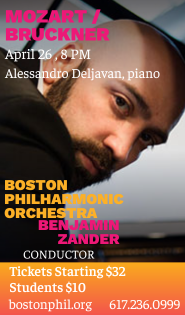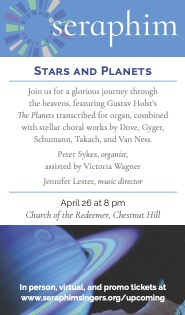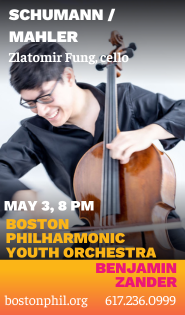Nosky, Handel and Haydn, check out five items from “Mendelssohn’s Library”
Imagine if you could go to a great composer’s house and see what’s in his record collection.
Felix Mendelssohn, of course, didn’t have a record collection. He had something better: shelves and shelves of printed music by masters of the past, and friends and family to play it all with.
But one wonders if even the prodigious Mendelssohn and his crew tore through the music of Vivaldi and C.P.E. Bach with the combination of pinpoint accuracy and abandon displayed by the Handel and Haydn Society Friday night in New England Conservatory’s Jordan Hall.
The thirteen players—twelve strings and a harpsichord—required no conductor to achieve their tight ensemble, just the eloquent body language of their concertmaster, Aisslinn Nosky.
Since taking that post in 2011, Nosky has been one of this city’s most watchable musicians, both for her fiery violin playing and her advanced fashion sense. In the public mind, the soaring phrases and the blazing scales have become inseparable from the radically tailored outfits and the magenta hair.
It seemed only a matter of time before the Society’s artistic director Harry Christophers and the other good men who conduct the group stepped aside for an evening and honored another 18th-century performance practice: the first violinist leading the performance.
The group’s theme Friday night was “Mendelssohn’s Library,” an attempt to see inside the mind of the young genius by playing the music he played and studied, concluding with a Concerto for Violin and Strings in D minor that he composed when he was 13.
Three Baroque contemporaries—Handel, Vivaldi, and J.S. Bach—provided the program’s first half. The twelfth and last concerto grosso from Handel’s landmark set of Op. 6 was an around-the-world trip in itself, its five movements consisting of a dignified Largo, a chattering Allegro, a tuneful Aria, another Largo with lively variations, and a whirling Allegro in gigue rhythm. A dance pulse moved throughout the piece, even in the Largos.
Vivaldi’s Concerto in G major “Alla Rustica” for strings without a soloist might make the Guinness Book as World’s Shortest Concerto, especially as performed Friday night. Its three movements—two bits of fast country fiddling framing an emphatic Adagio—were over in five or six minutes, time enough to display the kind of athletic vigor and harmonic daring that must have captivated Mendelssohn.
J.S. Bach’s contemporaries noticed that his music was an order of magnitude more intricate than anybody else’s, as witness the popular D minor Concerto for Two Violins and Strings, BWV 1043. The constant intertwining of lines in the string orchestra and between the two soloists on Friday was a puzzle to the listener’s ear and the night’s severest test of playing together without a conductor.
The Handel and Haydn players passed that test and also another, unexpected test of alertness: During the first movement, a tuning peg apparently slipped on soloist Christina Day Martinson’s instrument. When she stopped playing in mid-phrase, the entire ensemble halted on a dime with her.
The movement was restarted from the beginning, and one’s second impression was the same as the first: fleet, light playing that was a welcome alternative to more ponderous performances, but also a little on the facile side. The playing style that gives simpler, more tuneful Baroque music extra pep and punch can also skim over the wealth of detail in a J.S. Bach score.
Similarly, Nosky and her group raised the second movement’s slow three-to-a-bar (Largo ma non tanto, “broad but not very”) to nearly minuet tempo, turning “not very” to “hardly at all.” But in this case the gentle dance pulse gave the music a lift, partly compensating for the shortening of those gorgeously long solo lines, and the other players followed the soloists in subtle fluctuations of tempo that brought the music alive.
In the finale, driven by a whipping mordent upbeat, incisive playing by all helped the listener track the music’s close imitations despite the breathless tempo.
One reason this music is so familiar is that, over the years, it has attracted dueling virtuosos in “Three Tenors”-style performances and recordings. Bach’s imitative writing for the soloists continually prompted the question, Who’s playing now, Milstein or Heifetz? Menuhin or Szigeti? Isaac Stern or the eighth-grader from the Bronx?
Soloists Martinson and Nosky weren’t jostling for the limelight Friday night, but the differences in their sound and style added interest to the performance nevertheless. Not knowing all the details about their period-style violins, one could still note Martinson’s more arched Baroque bow and the round tone it drew from the gut string compared to Nosky’s clear, silvery tone.
And in the appearances-can-be-deceiving department, the more unconventional-looking Nosky tended to be the straightarrow about playing right on the beat, while Martinson found ways to take expressive liberties even at very fast tempos.
Throughout the evening, Nosky played the cheerful host, treating the intimate Jordan Hall as her living room and the audience as party guests. She also proved as adept with a microphone as with a violin, devoting most of her comments from the stage to Carl Philipp Emanuel Bach, the son of Johann Sebastian, born 300 years ago this year.
When Haydn was asked what composers influenced him the most, he cited “the great Bach,” referring not to old Sebastian but to Emanuel, the influential court musician to Frederick the Great, author of a classic treatise on keyboard playing, and composer of strange and wonderful music that still sounds avant-garde today.
Emanuel’s empfindsamer Stil (sensitive style) involved clearing away Baroque complications that inhibited direct expression, and on Friday one heard him opening a door for Haydn in the limpid Poco Adagio second movement of his Symphony in B-flat major, Wq. 182/2.
But that style also involved sudden contrasts of mood and harmonic hairpin turns that haven’t lost their power to startle. “And now for something completely different” seemed to be the watchword for the first movement of this concise three-movement symphony, in which the players managed to clearly characterize moods and themes that seemed to last only a few seconds before giving way to something else from the composer’s fertile imagination.
The finale’s whirring 16th notes and ripping scales provided another virtuoso turn for this tight band. Such were the expectations created by hearing so many short movements that when this one passed the three-minute mark, one thought it was getting awfully long.
Young Mendelssohn was also fairly prodigal with ideas in his Violin Concerto. They were not of the caliber of the ideas he would have three years later in his Overture to A Midsummer Night’s Dream; as so often in juvenile works of the masters, the phrases were a bit square and predictable. But there were glimmers of the Mendelssohn to come in characteristic touches such as the sighing “feminine endings” of many phrases and the delight he took in contrasting crisp, animated passages with smooth, melting ones.
As soloist and orchestra leader, Nosky made the most of what was there, playing with elfin leggiero one moment and sawing away the next. Not much could be done for the second movement, whose slow arpeggio theme seemed headed for imitation and exploration, but remained pretty much at the starting gate.
We know that heel-clicking gypsy finales were the rage in the late 19th century, but could teenage Mendelssohn have written one in Berlin in 1822? It seems improbable, but that is what this concerto’s hot last movement sounded like. It was one more star turn for soloist and orchestra, as the 16th notes scurried through all the parts like mice, until a brilliant coda capped the concerto and the evening, to rapturous applause.
And it’s true, it was thrilling to hear how swiftly and clearly and together these musicians could play. And we know that the old instruments don’t sustain as much, and historically-informed practice dictates brisker tempos.
But maybe if not absolutely every andante was pushed toward allegro, and every allegro toward presto, a program like this would venture into some other areas of expression, and contain a few more surprises for the listener. On the other hand, it’s good to catch an early train home.
The program will be repeated 3 p.m. Sunday at Harvard University’s Sanders Theatre. Handelandhaydn.org
Posted in Performances




